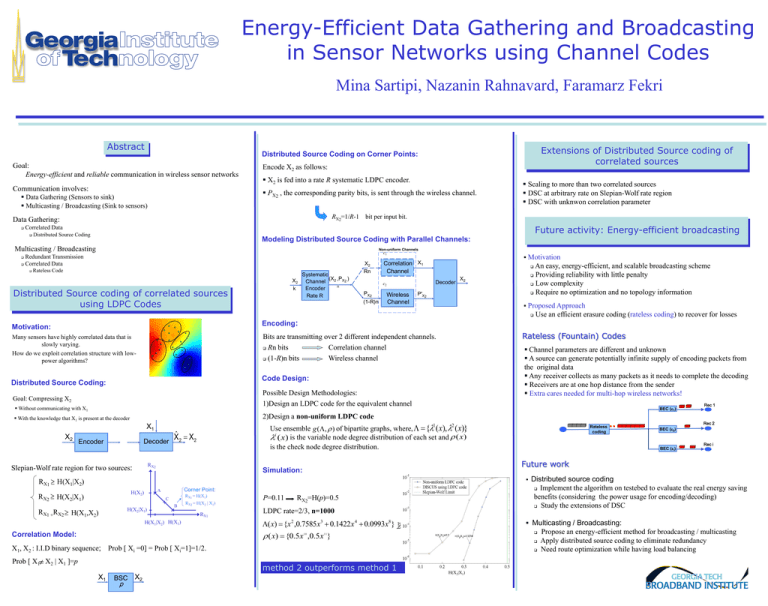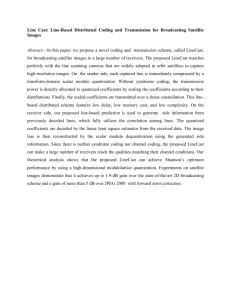DataGatheringBroadcasting.ppt: uploaded 18 April 2006 at 10:36 am
advertisement

Energy-Efficient Data Gathering and Broadcasting
in Sensor Networks using Channel Codes
Mina Sartipi, Nazanin Rahnavard, Faramarz Fekri
Abstract
Goal:
Energy-efficient and reliable communication in wireless sensor networks
Communication involves:
Encode X2 as follows:
X2 is fed into a rate R systematic LDPC encoder.
PX2 , the corresponding parity bits, is sent through the wireless channel.
Data Gathering (Sensors to sink)
Multicasting / Broadcasting (Sink to sensors)
Scaling to more than two correlated sources
DSC at arbitrary rate on Slepian-Wolf rate region
DSC with unknwon correlation parameter
RX2=1/R-1 bit per input bit.
Data Gathering:
Extensions of Distributed Source coding of
correlated sources
Distributed Source Coding on Corner Points:
Future activity: Energy-efficient broadcasting
Correlated Data
Distributed Source Coding
Modeling Distributed Source Coding with Parallel Channels:
Multicasting / Broadcasting
Non-uniform Channels
c1
Redundant Transmission
Correlated Data
Rateless Code
X2
k
Distributed Source coding of correlated sources
using LDPC Codes
X2
Rn
Systematic
(X2 ,PX2 )
Channel
n
Encoder
Rate R
Motivation
Correlation X1
Channel
Decoder
c2
PX2
(1-R)n
Wireless
Channel
An easy, energy-efficient, and scalable broadcasting scheme
Providing reliability with little penalty
Low complexity
Require no optimization and no topology information
X2
P'X2
Proposed Approach
Use an efficient erasure coding (rateless coding) to recover for losses
Encoding:
Motivation:
Channel parameters are different and unknown
A source can generate potentially infinite supply of encoding packets from
the original data
Any receiver collects as many packets as it needs to complete the decoding
Receivers are at one hop distance from the sender
Extra cares needed for multi-hop wireless networks!
Code Design:
Distributed Source Coding:
Possible Design Methodologies:
1)Design an LDPC code for the equivalent channel
Goal: Compressing X2
Without communicating with X1
BEC (1)
X1
Use ensemble g (, ) of bipartite graphs, where, { ( x), ( x)}
i (x) is the variable node degree distribution of each set and (x )
is the check node degree distribution.
1
Decoder
Encoder
Xˆ 2 X 2
RX2
Slepian-Wolf rate region for two sources:
2
Rateless
coding
Simulation:
Corner Point:
RX1 = H(X1)
C
+
RX1 +RX2 H(X1,X2)
H(X2|X1)
B
RX2 = H(X2 | X1)
RX1
H(X1|X2) H(X1)
P=0.11
RX2=H(p)=0.5
LDPC rate=2/3, n=1000
( x) {x ,0.7585x 0.1422 x 0.0993x }
2
3
4
8
( x) {0.5 x ,0.5 x }
Correlation Model:
10
X1
BSC
p
X2
0
Rec i
Distributed source coding
Implement the algorithm on testebed to evaluate the real energy saving
benefits (considering the power usage for encoding/decoding)
Study the extensions of DSC
11
X1, X2 : I.I.D binary sequence; Prob [ Xi =0] = Prob [ Xi=1]=1/2.
Prob [ X1 X2 | X1 ]=p
1
Multicasting / Broadcasting:
ber
A
BEC (2)
BEC (i)
H(X2)
Rec 2
0
Future work
RX1 H(X1|X2)
RX2 H(X2|X1)
Rec 1
1
0
2)Design a non-uniform LDPC code
With the knowledge that X1 is present at the decoder
X2
Rateless (Fountain) Codes
Bits are transmitting over 2 different independent channels.
Rn bits
Correlation channel
(1-R)n bits
Wireless channel
Many sensors have highly correlated data that is
slowly varying.
How do we exploit correlation structure with lowpower algorithms?
method 2 outperforms method 1
0.
H(X2|X1)
Propose an energy-efficient method for broadcasting / multicasting
Apply distributed source coding to eliminate redundancy
Need route optimization while having load balancing

